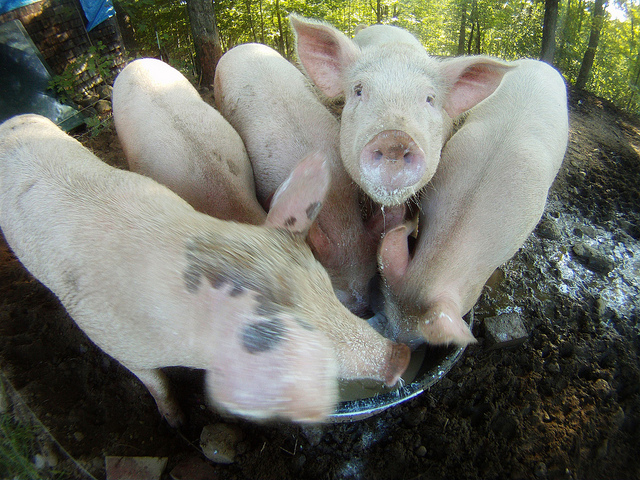Archive for January, 2019
Seeing What Isn’t There
 It’s relatively straightforward to tell the difference between activities that are done well and those that are done poorly. Usually sub-par activities generate visual signals to warn us of their misbehavior. A bill isn’t paid, a legal document isn’t signed or the wrong parts are put in the box. Though the specifics vary with context, the problem child causes the work product to fall off the plate and make a mess on the floor.
It’s relatively straightforward to tell the difference between activities that are done well and those that are done poorly. Usually sub-par activities generate visual signals to warn us of their misbehavior. A bill isn’t paid, a legal document isn’t signed or the wrong parts are put in the box. Though the specifics vary with context, the problem child causes the work product to fall off the plate and make a mess on the floor.
We have tools to diagnose the fundamental behind the symptom. We can get to root cause. We know why the plate was dropped. We know how to define the corrective action and implement the control mechanism so it doesn’t happen again. We patch up the process and we’re up and running in no time. This works well when there’s a well-defined in place, when process is asked to do what it did last time, when the inputs are the same as last time and when the outputs are measured like they were last time.
However, this linear thinking works terribly when the context changes. When the old processes are asked to do new work, the work hits the floor like last time, but the reason it hits the floor is fundamentally different. This time, it’s not that an activity was done poorly. Rather, this time there’s something missing altogether. And this time our linear-thinker toolbox won’t cut it. Sure, we’ll try with all our Six Sigma might, but we won’t get to root cause. Six Sigma, lean and best practices can fix what’s broken, but none of them can see what isn’t there.
When the context changes radically, the work changes radically. New-to-company activities are required to get the new work done. New-to-industry tools are needed to create new value. And, sometimes, new-to-world thinking is the only thing that will do. The trick isn’t to define the new activity, choose the right new tool or come up with the new thinking. The trick is to recognize there’s something missing, to recognize there’s something not there, to recognize there’s a need for something new. Whether it’s an activity, a tool or new thinking, we’ve got to learn to see what’s not there.
Now the difficult part – how to recognize there’s something missing. You may think the challenging part is to figure out what’s needed to fill the void, but it isn’t. You can’t fill a hole until you see it as a hole. And once everyone agrees there’s a hole, it’s pretty easy to buy the shovels, truck in some dirt and get after it. But if don’t expect holes, you won’t see them. Sure, you’ll break your ankle, but you won’t see the hole for what it is.
If the work is new, look for what’s missing. If the problem is new, watch out for holes. If the customer is new, there will be holes. If the solution is new, there will be more holes.
When the work is new, you will twist your ankle. And when you do, grab the shovels and start to put in place what isn’t there.
Image credit – Tony Atler
Growth Isn’t The Answer
 Most companies have growth objectives – make more, sell more and generate more profits. Increase profit margin, sell into new markets and twist our products into new revenue. Good news for the stock price, good news for annual raises and plenty of money to buy the things that will help us grow next year. But it’s not good for the people that do the work.
Most companies have growth objectives – make more, sell more and generate more profits. Increase profit margin, sell into new markets and twist our products into new revenue. Good news for the stock price, good news for annual raises and plenty of money to buy the things that will help us grow next year. But it’s not good for the people that do the work.
To increase sales the same sales folks will have to drive more, call more and do more demos. Ten percent more work for three percent more compensation. Who really benefits here? The worker who delivers ten percent more or the company that pays them only three percent more? Pretty clear to me it’s all about the company and not about the people.
To increase the number of units made implies that there can be no increase in the number of people required to make them. To increase throughput without increasing headcount, the production floor will have less time for lunch, less time for improving their skills and less time to go to the bathroom. Sure, they can do Lean projects to eliminate waste, as long as they don’t miss their daily quota. And sure, they can help with Six Sigma projects to reduce variation, as long as they don’t miss TAKT time. Who benefits more – the people or the company?
Increased profit margin (or profit percentage) is the worst offender. There are only two ways to improve the metric – sell it for more or make it for less. And even better than that is to sell it for more AND make it for less. No one can escape this metric. The sales team must meet with more customers; the marketing team must work doubly hard to define and communicate the value proposition; the engineering staff must reduce the time to launch the product and make it perform better than their best work; and everyone else must do more with less or face the chopping block.
In truth, corporate growth is the fundamental behind global warming, reduced life expectancy in the US and the ridiculous increase in the cost of healthcare. Growth requires more products and more products require more material mined, pumped or clear-cut from the planet. Growth puts immense pressure on the people doing the work and increases their stress level. And when they can’t deliver, their deep sense of helplessness and inadequacy causes them to kill themselves. And healthcare costs increase because the companies within (and insuring) the system need to make more profit. Who benefits here? The people in our community? The people doing the work? The planet? Or the companies?
What if we decided that companies could not grow? What if instead companies paid dividends to the people do the work based on the profit the company makes? With constant output wouldn’t everyone benefit year-on-year?
What if we decided output couldn’t grow? What if instead, as productivity increased, companies required people to work fewer hours? What if everyone could make the same number of products in seven hours and went home an hour early, working seven and getting paid for eight? Would everyone be better off? Wouldn’t the planet be better off?
What if we decided the objective of companies was to employ more people and give them a sense of purpose and give meaning to their lives? What if we used the profit created by productivity improvements to employ more people? Wouldn’t our communities benefit when more people have good jobs? Wouldn’t people be happier because they can make a contribution to their community? Wouldn’t there be less stress and fewer suicides when parents have enough money to feed their kids and buy them clothes? Wouldn’t everyone benefit? Wouldn’t the planet benefit?
Year-on-year growth is a fallacy. Year-on-year growth stresses the planet and the people doing the work. Year-on-year growth is good for no one except the companies demanding year-on-year growth.
The planet’s resources are finite; people’s ability to do work is finite; and the stress level people can tolerate is finite. Why not recognize these realities?
And why not figure out how to structure companies in a way that benefits the owners of the company, the people doing the work, the community where the work is done and the planet?
Image credit – Ryan
How to Prevent Depletion
 On every operating plan there are more projects than there are people to do them and at every meeting there more new deliverables than people to take them on. At every turn, our demand for increased profits pushes our people for more. And, to me, I think this is the reason every day feel fuller than the last.
On every operating plan there are more projects than there are people to do them and at every meeting there more new deliverables than people to take them on. At every turn, our demand for increased profits pushes our people for more. And, to me, I think this is the reason every day feel fuller than the last.
This year do you have more things to accomplish or fewer? Do you have more meetings or fewer? Do you get more emails or fewer?
We add work to people’s day as if their capacity to do work is infinite. And we add metrics to measure them to make sure they get the work done. And that’s a recipe for depletion. At some point, even the best, most productive people reach their physical and emotional limits. And at some point, as the volume of work increases, we all become depleted. It’s not that we’re moving slowly, being wasteful or giving it less than our all. When the work exceeds our capacity to do it, we run out of gas.
Here are some thoughts that may help you over the next year.
The amount of work you will get done this year is the same as you got done last year. But don’t get sidetracked here. This has nothing to do with the amount of work you were asked to do last year. Because you didn’t complete everything you were asked to do last year, the same thing will happen this year unless the amount of work on this year’s plan is equal to the amount of work you actually accomplished last year. Every year, scrub a little work off your yearly commitments until the work content finally equals your capacity to get it done.
Once the work content of your yearly plan is in line, the mantra becomes – finish one before you start one. If you had three projects last year and you finished one, you can add one project this year. If you didn’t finish any projects last year you can’t start one this year, at least until you finish one this year. It’s a simple mantra, but a powerful one. It will help you stop starting and start finishing.
There’s a variant to the finish-before-you-start approach that doesn’t have to wait for the completion of a long project. Instead of finishing a project, unimportant projects are stopped before they’re finished. This is loosely known as – stop doing before start doing. Stopping is even more powerful than finishing because low value work is stopped and the freed-up resources are immediately applied to higher value work. This takes judgement and courage to stop a dull project, but it’s well worth the discomfort.
If you want to get ahead of the game, create a stop-doing list. For each item on the list estimate how much time you will free up and sum the freed-up time for the lot. Be ruthless. Stop all but the most important work. And when your boss says you can’t stop something because it’s too important, propose that you stop for a week and see what happens. And when no one notices you stopped, propose to stop for a month and see what happens. Rinse and repeat.
When the amount of work you have to get done fits with your capacity to do it, your physical and mental health will improve. You’ll regain that spring in your step and you’ll be happier. And the quality of your work will improve. But more importantly, your family life and personal relationships will improve. You’ll be able to let go of work and be fully present with your friends and family.
Regardless of the company’s growth objectives, one person can only do the work of one person. And it’s better for everyone (and the company) if we respect this natural constraint.
On Gumption
 Doing new work takes gumption. But there are two problems with gumption. One, you’ve got to create it from within. Two, it takes a lot of energy to generate the gumption and to do that you’ve got to be physically fit and mentally grounded. Here are some words that may help.
Doing new work takes gumption. But there are two problems with gumption. One, you’ve got to create it from within. Two, it takes a lot of energy to generate the gumption and to do that you’ve got to be physically fit and mentally grounded. Here are some words that may help.
Move from self-judging to self-loving. It makes a difference.
It’s never enough until you decide it’s enough. And when you do, you can be more beholden to yourself.
You already have what you’re looking for. Look inside.
Taking care of yourself isn’t selfish, it’s self-ful.
When in doubt, go outside.
You can’t believe in yourself without your consent.
Your well-being is your responsibility. And it’s time to be responsible.
When you move your body, your mind smiles.
With selfish, you take care of yourself at another’s expense. With self-ful, you take care of yourself because you’re full of self-love.
When in doubt, feel the doubt and do it anyway.
If you’re not taking care of yourself, understand what you’re putting in the way and then don’t do that anymore.
You can’t help others if you don’t take care of yourself.
If you struggle with taking care of yourself, pretend you’re someone else and do it for them.
Image credit — Ramón Portellano
Advice To Young Design Engineers
If your solution isn’t sold to a customer, you didn’t do your job. Find a friend in Marketing.
If your solution can’t be made by Manufacturing, you didn’t do your job. Find a friend in Manufacturing.
Reuse all you can, then be bold about trying one or two new things.
Broaden your horizons.
Before solving a problem, make sure you’re solving the right one.
Don’t add complexity. Instead, make it easy for your customers.
Learn the difference between renewable and non-renewable resources and learn how to design with the renewable ones.
Learn how to do a Life Cycle Assessment.
Learn to see functional coupling and design it out.
Be afraid but embrace uncertainty.
Learn how to communicate your ideas in simple ways. Jargon is a sign of weakness.
Before you can make sure you’re solving the right problem, you’ve got to know what problem you’re trying to solve.
Learn quickly by defining the tightest learning objective.
Don’t seek credit, seek solutions. Thrive, don’t strive.
Be afraid, and run toward the toughest problems.
Help people. That’s your job.
Image credit – Marco Verch

 Mike Shipulski
Mike Shipulski